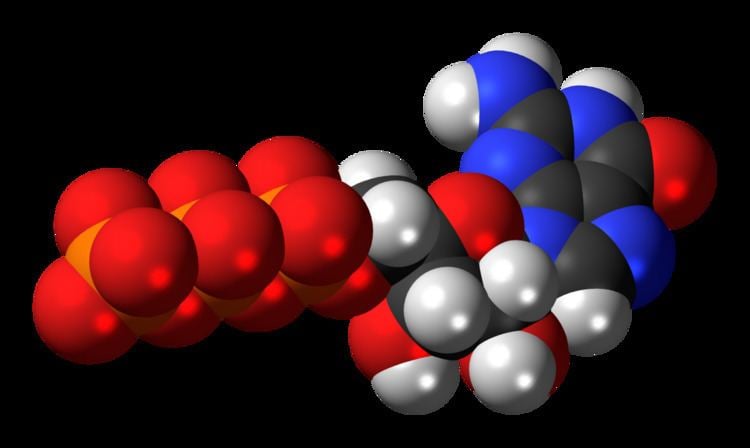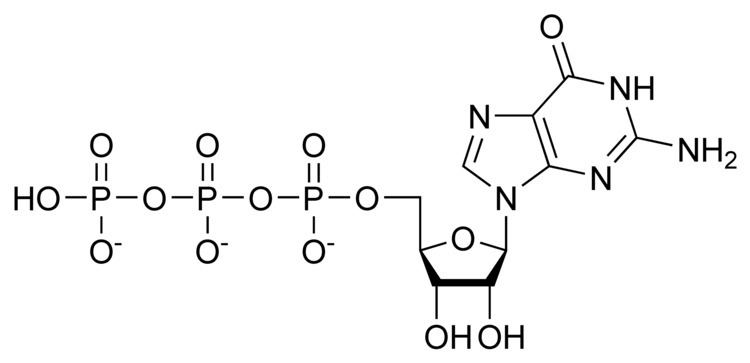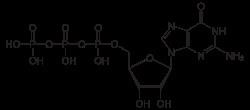Formula C10H16N5O14P3 | Molar mass 523.18 g/mol | |
 | ||
IUPAC ID [(2R,3S,4R,5R)-5-(2-amino-6-oxo-3H-purin-9-yl)-3,4- dihydroxyoxolan-2-yl]methyl (hydroxy-phosphonooxyphosphoryl) hydrogen phosphate | ||
Guanosine triphosphate
Guanosine-5'-triphosphate (GTP) is a purine nucleoside triphosphate. It can act as a substrate for both the synthesis of RNA during the transcription process and of DNA during DNA replication. ‹See TfD›Its structure is similar to that of the guanine nucleobase, the only difference being that nucleotides like GTP have a ribose sugar and three phosphates, with the nucleobase attached to the 1' and the triphosphate moiety attached to the 5' carbons of the ribose.
Contents
- Guanosine triphosphate
- Medical vocabulary what does guanosine triphosphate mean
- Energy transfer
- Genetic translation
- Microtubule dynamic instability
- Mitochondrial Function
- Biosynthesis
- cGTP
- References

It also has the role of a source of energy or an activator of substrates in metabolic reactions, like that of ATP, but more specific. It is used as a source of energy for protein synthesis and gluconeogenesis.

GTP is essential to signal transduction, in particular with G-proteins, in second-messenger mechanisms where it is converted to guanosine diphosphate (GDP) through the action of GTPases.

Medical vocabulary what does guanosine triphosphate mean
Energy transfer

GTP is involved in energy transfer within the cell. For instance, a GTP molecule is generated by one of the enzymes in the citric acid cycle. This is tantamount to the generation of one molecule of ATP, since GTP is readily converted to ATP with nucleoside-diphosphate kinase (NDK).
Genetic translation

During the elongation stage of translation, GTP is used as an energy source for the binding of a new amino-bound tRNA to the A site of the ribosome. GTP is also used as an energy source for the translocation of the ribosome towards the 3' end of the mRNA.
Microtubule dynamic instability

During microtubule polymerization, each heterodimer formed by an alpha and a beta tubulin molecule carries two GTP molecules, and the GTP is hydrolyzed to GDP when the tubulin dimers are added to the plus end of the growing microtubule. Such GTP hydrolysis is not mandatory for microtubule formation, but it appears that only GDP-bound tubulin molecules are able to depolymerize. Thus, a GTP-bound tubulin serves as a cap at the tip of microtubule to protect from depolymerization; and, once the GTP is hydrolyzed, the microtubule begins to depolymerize and shrink rapidly.
Mitochondrial Function
The translocation of proteins into the mitochondria matrix involves the interactions of both GTP and ATP. The importing of these proteins plays an important role in several pathways regulated within the mitochondria organelle.
Biosynthesis
In the cell, GTP is synthesised through many processes including:
cGTP
Cyclic guanosine triphosphate (cGTP) helps cyclic adenosine monophosphate (cAMP) activate cyclic nucleotide-gated ion channels in the olfactory system.
